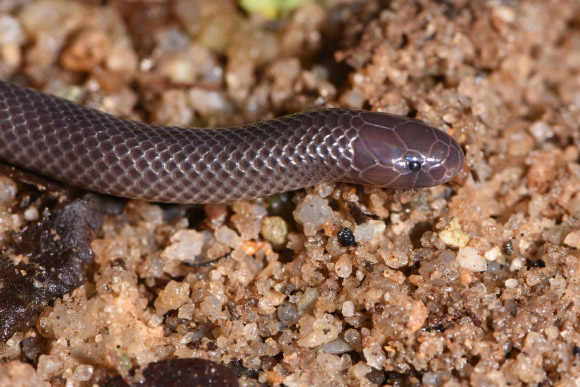A new species of stiletto snake has been discovered living in the rainforests of Liberia and Guinea.

The Branch’s stiletto snake (Atractaspis branchi) in its natural habitat. Image credit: Mark-Oliver Rödel.
The stiletto snakes, also known as burrowing asps, are members of Atractaspis, a genus with over 20 validly described species.
These burrowing and venomous snakes are famous for their unique skull anatomy and venom delivery system, allowing them to attack and stab sideways with a fang sticking out of the corner of their mouths.
While most of these snakes are not venomous enough to kill a human, this behavior makes them impossible to handle using the standard approach of holding them with fingers behind the head. In fact, they can even stab with their mouths closed.
The stiletto snakes live in a wide range of habitats in sub-Saharan Africa. Only two species occur in the Middle East and Arabia.
The newfound species, named the Branch’s stiletto snake (Atractaspis branchi), lives in primary rainforest and rainforest edges of western Liberia and southeastern Guinea.
“The Branch’s stiletto snake is most likely endemic to this area, a threatened biogeographic region already known for its unique and diverse fauna,” said Dr. Mark-Oliver Rödel from the Museum für Naturkunde in Berlin, Germany, and colleagues.
“The first specimen of the species was collected at night from a steep bank of a small rocky creek in a lowland evergreen rainforest in Liberia.”
“Upon picking it up, the snake tried to hide its head under body loops, bending it at an almost right angle, so that its fangs were partly visible on the sides. Then, it repeatedly stroke.”
“The other two specimens used for the description of the species were collected from banana, manioc and coffee plantations in south-eastern Guinea, about 18 miles (27 km) apart.”
“The discovery of a new and presumably endemic species of fossorial snake from the western Upper Guinea forests thus is not very surprising,” the scientists added.
“However, further surveys are needed to resolve the range of the new snake species, and to gather more information about its ecological needs and biological properties.”
A paper reporting this discovery is published in the journal Zoosystematics and Evolution.
_____
M. Rödel et al. 2019. A new stiletto snake (Lamprophiidae, Atractaspidinae, Atractaspis) from Liberia and Guinea, West Africa. Zoosystematics and Evolution 95 (1): 107-123; doi: 10.3897/zse.95.31488







